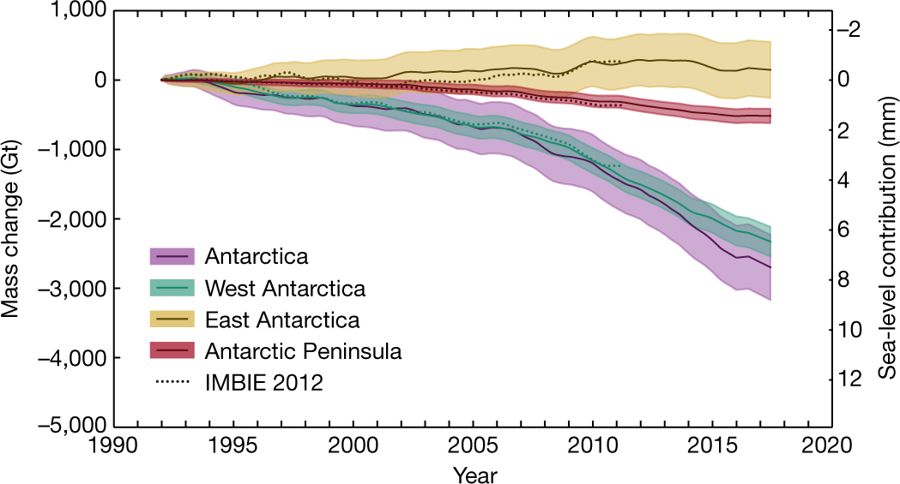Mass balance of the Antarctic Ice Sheet from 1992 to 2017
by A. Shepherd, E. Ivins, E. Rignot, B. Smith,
M. van den Broeke, I. Velicogna, P. Whitehouse,
K. Briggs, I. Joughin, G. Krinner, S. Nowicki,
T. Payne, T. Scambos, N. Schlegel, G. A,
C. Agosta, A. Ahlstrøm, G. Babonis,
V. Barletta, A. Blazquez, J. Bonin, B. Csatho,
R. Cullather, D. Felikson, X. Fettweis, R. Forsberg,
H. Gallee, A. Gardner, L. Gilbert, A. Groh,
B. Gunter, E. Hanna, C. Harig, V. Helm,
A. Horvath, M. Horwath, S. Khan, K. K. Kjeldsen,
H. Konrad, P. Langen, B. Lecavalier, B. Loomis,
S. Luthcke, M. McMillan, D. Melini, S. Mernild,
Y. Mohajerani, P. Moore, J. Mouginot, G. Moyano,
A. Muir, T. Nagler, G. Nield, J. Nilsson,
B. Noël, I. Otosaka, M. E. Pattle, W. R. Peltier,
N. Pie, R. Rietbroek, H. Rott,
L. Sandberg-Sørensen, I. Sasgen, H. Save,
B. Scheuchl, E. Schrama, L. Schröder, K.-W. Seo,
S. Simonsen, T. Slater, G. Spada, T. Sutterley,
M. Talpe, L. Tarasov, W. J. van de Berg,
W. van der Wal, M. van Wessem,
B. Dutt Vishwakarma, D. Wiese and B. Wouters
Nature (2018)
Abstract:
The Antarctic Ice Sheet is an important indicator of climate change and
driver of sea-level rise. Here we combine satellite observations of its
changing volume, flow and gravitational attraction with modelling of its
surface mass balance to show that it lost 2,720 ± 1,390 billion tonnes
of ice between 1992 and 2017, which corresponds to an increase in mean sea
level of 7.6 ± 3.9 millimetres (errors are one standard deviation).
Over this period, ocean-driven melting has caused rates of ice loss from
West Antarctica to increase from 53 ± 29 billion to 159 ± 26
billion tonnes per year; ice-shelf collapse has increased the rate of ice
loss from the Antarctic Peninsula from 7 ± 13 billion to 33 ± 16
billion tonnes per year. We find large variations in and among model
estimates of surface mass balance and glacial isostatic adjustment for
East Antarctica, with its average rate of mass gain over the period
1992–2017 (5 ± 46 billion tonnes per year) being the least certain.
